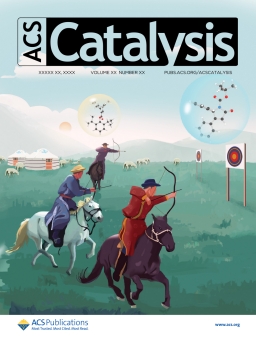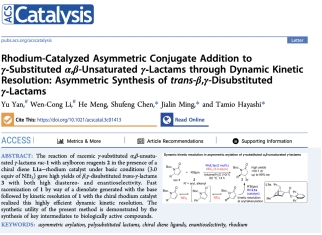Recently, Research Fellow Ming Jialing who joined IMU under “Steed Program”-a high-level talent attraction program, has published his latest research result in organic synthesis-asymmetric catalysis in ACS Catalysis, an international top journal which is rated TOP journal by Chinese Academy of Sciences and whose effect factor is 13.7. The research result is titled “Rhodium-Catalyzed Asymmetric Conjugate Addition to γ-Substituted α,β-Unsaturated γ-Lactams through Dynamic Kinetic Resolution: Asymmetric Synthesis of trans-β,γ-Disubstituted γ-Lactams”. It is published as cover article. ACS Catalysis is a top journal under ACS which is influential in the organic homogeneous catalytic synthesis chemistry.

Optically pure chiral poly-substituted γ-lactam widely exists as core structure in bioactive molecules. For example, clausenamide, is an active poly-substituted γ-lactam isolated from the leaves of clausena lansium which, under the normal physiological and pathological conditions, can improve cognitive function and be used for the treatment of Alzheimer. Chemists have been focusing on beginning with easily-available starting materials and preparing chiral compounds with some sterocenters. Dynamic kinetic resolution(DKR) has become one of the important methods for preparing chiral compounds, which start with easily-available racemized materials and efficiently transform into target molecules with sterocenters. With rhodium, a chiral diene ligand, as catalyst, Research Fellow Ming Jialin catalyzed DKR of unsaturated lactams and generated asymmetric arylation. And the enantioselectivity is as high as 99% ee and diastereoselectivity is 50:1.

With the method, the successful asymmetric synthesis of Phenchlobenpyrrone, a new medicine to treat Alzheimer, was made. The medicine was invented by Hao Xiaojiang, academician with Kunming Institute of Botany, Chinese Academy of Sciences and has entered the iib-phase clinical trial in 2020. In addition, another four optically pure active biomolecules were synthesized with the method. The experiments for adequate mechanism study elaborated the factors that influence DKR including quantity of organic alkaline, steric hindrance of organic alkaline and protecting group of lactam.
The research has been jointly completed by Research Fellow Ming Jialin’s research team and Prof. Chen Shufeng’s research team. The co-authors of the article are Yan Yu and Li Wencong, two PhD candidates of Inner Mongolia University. Ming and Chen are co-corresponding authors of the article. Inner Mongolia University is the institution the authors of the article are with. The research is supported by the National Natural Science Foundation of China(Grant Numbers: 22261039 and 22061031).
URL of the article: https://doi.org/10.1021/acscatal.3c01413
URL of Research Fellow Ming Jialing’s research team: https://www.x-mol.com/groups/ming_jialin

